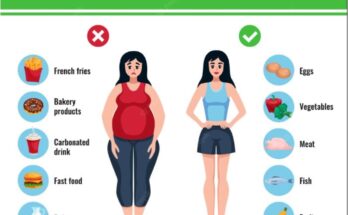
Plastic wrap used on cucumbers has been found to contain phthalates.
J Rosello/iStockphoto/Getty Images
hide description
toggle caption
J Rosello/iStockphoto/Getty Images
Thousands of chemicals used in food packaging and food production are leaching into the food itself.
“Must be [from] your soda can, your plastic cookware, your non-stick pan, the cardboard box your refrigerators come in,” says Jane Muncke, a toxicologist based in Zurich. “It’s packing grocery stores, but also cooking supplies, and yours [kitchenware] and table food at home.”

More than 3,600 chemicals found in food packaging are also found in the human body, according to a paper published on Tuesday. Journal of Exposure Science & Environmental Epidemiology. The research was led by Muncke and his colleagues at the Food Packaging Forum Foundation, a non-profit research group focused on hazardous chemicals in food packaging.
This paper synthesizes data from other published sources that report the presence of certain chemicals in humans from blood, urine and breast milk samples. Of the 3,600 chemicals found in food and humans, researchers say about 80 are known to be “hazardous substances of major concern” to human health.
Heat and time accelerate leaching
Many of the chemicals in food packaging are plastic compounds and can be found in clothing, furniture and personal care products. But Muncke says food packaging is a big concern, because it can contaminate what people eat.
A food processor may treat the food with chemicals. You may have noticed this if you’ve ever stored tomato sauce in a plastic tub and noticed a red residue in the unwashed container. “That’s because the molecules, which give the sauce its red color, are already embedded in the plastic,” Muncke says. “That goes the other way too – the chemicals from your plastic can become food.”
Chemical leaching can be accelerated by temperature, time, whether the food is acidic or fatty, or how much food touches the container.
It is highly sensitive to other chemicals
Most of the 3,600 chemicals have not been well studied for their health effects.
But others have known relationships and life problems. The study identified about 80 chemicals on the list of “high concern” – linked to conditions such as cancer, developmental disorders, heart and metabolic diseases.
“Chemicals like phthalates, bisphenols, metals – I think there is strong evidence to suggest that there are negative health effects,” says Dr. Robert Sargis, an endocrinologist at the University of Illinois who was not involved in the study, although he worked with them. Muncke to others.
For example, phthalates are known endocrine disruptors and can interfere with the body’s hormones. They are used to make flexible and durable plastics, such as cucumber wraps in the grocery store.
Chemicals can be difficult for consumers to spot and avoid. “The fact of the matter is, we don’t know where these things are, and we don’t know 100% what’s happening to us,” says Sargis.
Chemicals can begin to detoxify the body within days
The effects of these chemicals can accumulate over time, contributing to chronic conditions such as obesity, diabetes and heart disease, says Dr. Leonardo Trasande, a pediatrician and director of the Environmental Risk Research Center at NYU Langone Health. Trasande was not involved in this study, although he collaborated in the specialized field of health and plastic research with Muncke and Sargis.
In a study published earlier this year, Trasande and his colleagues estimated that health problems related to exposure to harmful chemicals in plastic cost US$250 billion a year. The analysis included direct medical costs and indirect costs, such as lost productivity due to disability. “We didn’t do that [look into] food packaging is part of that, but I would say it’s probably the biggest driver,” Trasande says.
It is possible to reverse some of the health effects by reducing the use of chemicals, Trasande says. He says some of these chemicals, such as BPA and phthalates, can begin to detoxify the body within days of stopping exposure. “If you support those measures, you change your hormone levels in weeks, and you change your mortality in months,” he says.
Trasande recommends against microwaving or dishwasher plastic containers. He says that stainless steel and glass are less likely to react with chemicals in food.
Researchers say regulators could do more to help by requiring proper labeling of chemicals on food packages. That can help consumers make better choices. Restrictions on chemicals with known risks in food production and packaging can also help. “We need to get out of the rabbit hole of focusing on plastic bags as a way to reduce plastic exposure,” Trasande says. “We need to think about food packaging.”
The Foodservice Packaging Institute and the Plastics Industry Association did not respond to requests for comment.
In testimony given by the conference on Sept. 10, Jim Jones, deputy commissioner of human food at the Department of Food and Drug Administration, said: “The food industry has a responsibility to ensure the safety of the chemicals they use in food, to including food packaging. and other food contact materials, and FDA’s ability to evaluate the safety of these ingredients in the food supply depends on the availability of this safety data. ” However, he noted, “Congress, federal legislatures, and stakeholders have made it clear that chemical safety is an important issue for us to address.”
The FDA will hold a public meeting on September 25 to discuss how to improve the agency’s oversight of food chemicals, including food packaging.
#Harmful #chemicals #food #packaging #humans



